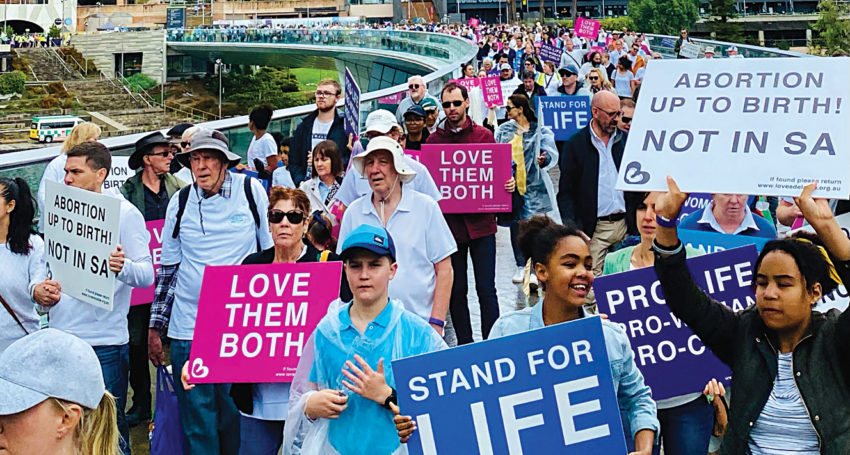Changing hearts and minds on abortion
Opinion
In the aftermath of the abortion debate, it is important that we understand the significance of the law which passed in February.

Those supporting the new abortion law such as Attorney General Vickie Chapman, the SA Law Society and the Australian Medical Association ran a disingenuous campaign of ‘nothing to see here’.
They said it was about decriminalisation and that current medical practices would not change. This was despite the fact that those against the abortion law were not opposed to decriminalisation.
Love Adelaide – a broad coalition of groups against Chapman’s law – supported taking abortion out of the criminal code and adopting a health care model. Its main concern was that it would allow abortion until birth.
Advertisement
Yet, frustratingly, this was denied again and again by those in support of the new law who said it would not increase the number of late term abortions or change medical practices.
Both statements were entirely untrue and grossly misleading.
To be clear, under the old law an abortion was not permitted after a child was capable of being born alive unless it was to save the life of the mother. When this law was written, this was 28 weeks but with developments in medical science the threshold is now 22 weeks and six days. So previously, abortion was only possible after viability for no reason other than to save the mother’s life.
The Attorney General sought to allow abortion until birth if two doctors agreed it were ‘medically appropriate’. This was not defined and had the potential to include a wide range of reasons, including mental, physical or psycho-social reasons.
Understandably, many South Australians and their MPs were outraged by this significant departure from the old law, as evidenced by 5000 people marching in protest.
On the first evening of debate in the Lower House, there was passionate opposition to passing a law that would allow the abortion of viable babies.
In an eleventh hour bid to save her own law’s fate, the Attorney General overnight developed an amendment which proposed replacing ‘medically appropriate’ with allowing abortion until birth in cases where ‘the continuation of the pregnancy would involve significant risk of injury to the physical or mental health of the pregnant person’.
In reality, the only change was in the wording, not in its substantive effect.
But the change created confusion and allowed Chapman to argue that she’d listened to MPs’ concerns and was introducing greater restrictions on access to late term abortion.
Nothing could be further from the truth.
In reality, a ‘medically appropriate’ reason encompasses physical or mental health. In fact, it is difficult to conceive of a ‘medically appropriate’ reason that does not involve a pregnant woman’s physical or mental health.
In SA, prior to gestational viability and in other jurisdictions which allow abortion until birth for mental health reasons, the single most common reason for abortion is ‘mental health’ and it is broadly interpreted.
Advertisement
For example, in SA in 2017, of the 4349 abortions undertaken prior to gestational viability, 4146 abortions (95.3 per cent) were attributed to being for a ‘mental health’ reason.
These nuances and facts were not understood on the second night of the debate.
In a devastating outcome for the rights of in-utero babies, Chapman’s amendment was passed. Its effect was to change SA’s prior model of protecting unborn babies who were capable of being born alive with a new law allowing abortion until birth for a broad range of reasons.
And despite Chapman’s protestations that her law would not increase the number of late term abortions, the evidence in other jurisdictions does not support this.
In Victoria this same model has led to more than 600 abortions after 23 weeks for purely maternal psycho-social reasons over a 10-year period. None of these were to save the mother’s life or because of the baby’s health. It has also led to the abortion of five perfectly healthy babies at 37 weeks for ‘psycho-social reasons’.
In a silver lining, a final amendment was made by Labor MP Stephen Mullighan, after Chapman’s amendment passed. Mullighan surprised everyone by proposing a prescribed checklist for late term abortions using RANZCOG guidelines. The final vote for his amendment was tied at 23–23 with the Speaker casting the deciding vote for the amendment. Mullighan’s intervention means that SA now has at least some guidelines for when late term abortion can occur.
In the end, abortion until birth was only passed because of a handful of votes. This demonstrates how important it is to know what your candidates’ position is on abortion prior to voting at the next election. Who we have in Parliament matters.
Labor Opposition Leader Peter Malinauskas should be commended for his courageous vote against late term abortion. It is in stark contrast to the Premier’s own position on this. Appallingly, for most of the debate on this historic and important law, Premier Marshall did not even bother to attend the Lower House debate and only turned up to vote.
Ultimately, the tide will only turn against abortion when we change people’s hearts and minds. As developments in medical science improve, this will only get easier. It is no longer possible to argue, as pro-abortionists used to, that an in-utero baby is ‘a collection of cells’.
South Australians who care about the human rights of the unborn need to stay in this fight. In-utero babies are the most vulnerable members of our society. This is the human rights issue of our time. We need to have this conversation, one person at a time, and show how abortion hurts the pregnant woman and ends the life of an innocent baby.
Dr Joanna Howe is an Associate Professor of Law and a former NSW Rhodes Scholar.








Comments
Show comments Hide comments